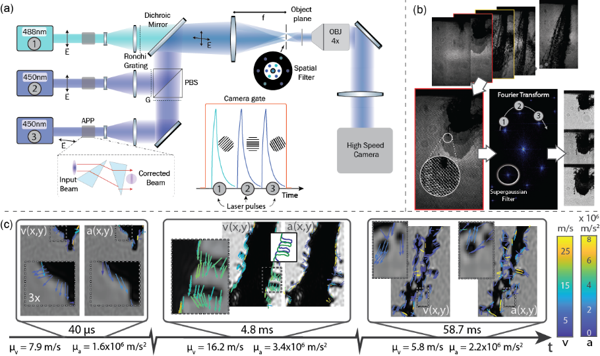Fast transient events, such as chemical reactions, plasma formation and laser induced damage involve processes that occur at different timescales. Consider for example a plasma assisted reaction event. On the one hand the actual discharge necessitates ultra-high imaging speeds in order to capture its evolution (on the order of THz), while on the other hand, the shockwave induced by the chemical reactions following the plasma pulse moves at a much slower rate.
Today's technology is in an either/or situation when it comes to snapshot imaging: either one can image in the THz range with ultrafast laser technology for an extremely restricted amount of time, or one can image in the kHz range continuously. To put numbers on these concepts, high speed imaging cameras such as the Photron SA5 can comfortably image at e.g. 100kHz over a period of 5 seconds while an ultrafast imaging technique invented here in Lund University Sweden (under the name FRAME) has been shown to image at a speed of 5 THz but only over a period of 600 femtoseconds (0.000000000000600 s).
To address the problems, the research group led by Elias Kristensson at the Division of Combustion Physics, Lund University, Sweden has been able to address said gap in videography speed vs video length by combining laser based ultrafast imaging with regular high-speed cMOS cameras. The efficiency of this hybridization was illustrated by, for the first time, extracting accelerometry vector fields of a highly chaotic spray injection over the course of the entire event (lasting 70ms). The relevant research results were published in Photonics Research, Volume 10, No. 7, 2022 (Vassily Kornienko, David Andersson, Mehdi Stiti, Jonas Ravelid, Simon Ek, Andreas Ehn, Edouard Berrocal, Elias Kristensson. Simultaneous multiple time scale imaging for kHz–MHz high-speed accelerometry[J]. Photonics Research, 2022, 10(7): 1712).
The presented research employs the Frequency Recognition Algorithm for Multiple Exposures (FRAME) technique. By uniquely labelling individual pulses within a pulse train and collecting all the superimposed information on a single camera sensor within a single exposure, one can subsequently extract the individual pulse information by identifying the labels in the post processing step. This has been shown to produce THz videos of a travelling pulse of light. In this research three high repetition-rate nanosecond laser sources are individually pulsed within a single camera gate (inset of Fig. 1a).
Each beam passes through a set of optics (beam correcting/expanding optics, Ronchi grating, and imaging optics) before arriving at the sample. These have the effect of labelling the individual pulses with intensity modulations before being recombined into a pulse train incident on the sample. This pulse train, imprinted with the labels and event information is then imaged with a home-made microscope on a Photron SA5 camera. By pulsing the lasers at a repetition rate identical to the camera's, a series of spatially modulated images are aquired of the event (Fig. 1b) where a single example is framed in red. The extraction occurs in the so-called Fourier Domain via a lock-in algorithm, resulting in image triplets separated in time by the set interpulse times between the laser sources.

Figure 1: Extracting accelerometry data at kHz to MHz rates. a) Three multiplexed ns lasers are fired for every camera exposure. b) Extracting the image triplets via lock-in amplification c) Velocity and subsequently acceleration maps are extracted.
Since image triplets are acquired, algorithmic extraction of velocity and acceleration vector fields is made possible, illustrating the chaotic nature of the liquid injection. We further show the ability to extract certain quantities such has the air resistance experienced by single droplets that have disintegrated from the main body. Fig. 1c shows three snapshots of extracted velocity and acceleration fields at three different times during the course of the injection event. A supplementary video of the evolution of these fields are included in the original article.
While the development of double-framed cameras and burst lasers has enabled velocimetry, the measurement of acceleration has been restricted to the use of multiple camera optical configurations. Furthermore the technological gap restricting the videography of simultaneously occuring kHz and MHz/THz events, limits access to a large range of natural phenomena. We believe that hybridization between high-speed cameras with ultrafast laser sources will open the doors to measuring a plethora of natural phenomena that have thus far been inaccessible.







